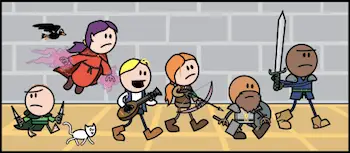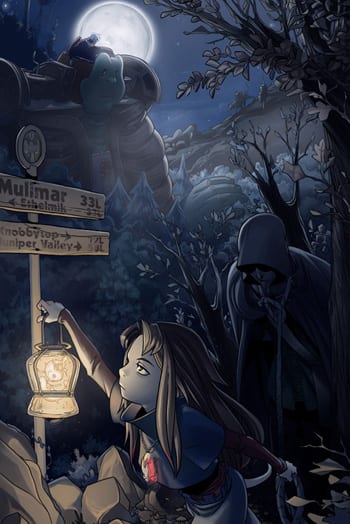Greetings, readers of the Fandomentals. In the past, I have… well mostly complained about things, really. But we stick to what we do best, right? I have also introduced you to some things I enjoyed, and this time I would like to talk about some webcomics. Now, there’s no shortage of those, which means I have a reason I present you those three, specifically.
“Order of the Stick”
By Rich Burlew

Ah, “Order of the Stick.” This webcomic has been a journey for me. It might not be an exaggeration to say I wouldn’t be here without it… I certainly wouldn’t talk so much about tabletop gaming. But it hasn’t only been a journey for me. The comic itself has also had a wild ride.
You see, it began as a very simple affair, with one joke per page, and an audience consisting of about a dozen people on its author’s personal forum. But said author, Rich Burlew commonly called “the Giant,” wasn’t going to stop there.
The comic’s original focus was jokes about the 3rd edition of Dungeons & Dragons. The very first strip makes highly specific references about the 3.5 rules revision, which had just come out back then. Needless to say, those jokes don’t hold up very well today. The edition is still alive and played, but D&D’s mainstream face is the fifth one. This may prove to be a barrier for new readers, together with a very simplistic and crude art style.
If you can muddle through the old dusty jokes, though, you’ll see a story that unfolds from them. In a different sense than usual. Those characters were originally vessels for jokes, without any particular continuity or depth. When Rich Burlew decided to craft a story, he had to build it around these simple origins.
Roy Greenhilt, the team’s leader, was originally just a human fighter who had to wrangle five less-than-stable elements he’d been saddled with. Durkon Thundershield was a dwarven cleric and a (as the comic itself jokes early on) walking band-aid. Elan the bard was just dim-witted comic relief, while Haley Starshine was a greedy, sneaky rogue. Vaarsuvius was the model of an arrogant elven wizard and finally Belkar Bitterleaf the halfling ranger was a vessel for darker jokes due to his deep-seated issues and unbridled aggression.
In time, this rather typical rag-tag band of misfits received individual character arc that resonate on a deeper level and turn them into a more coherent team in different ways. The comic has always been a comedy, and still is, but it’s become more… elaborate in many ways. The writing, the art, the characters. It’s not just entertainment, but a way to make a statement. Fiction matters, as we like to say on this here site, and Rich Burlew knows it well.
Which happens to extend to issues closer to reality as well. The representation of some groups, notably women and LGBT folks, wasn’t always great. But in recent years Rich Burlew took steps to rectify that, citing that it’s his responsibility as a popular author in a genre that still struggles with the subject.
The two overarching villains of the comic (not that there aren’t many more) underwent a similar process. Xykon was originally just a lich sorcerer the party was out to fight. Now… well, he’s not really that much more. Rich Burlew deliberately didn’t give him significant depth. Instead, he’s just a terrifying unstoppable force. He’s incredibly powerful and has no hesitation about taking what he wants with this power. He’s the kind of villain you cannot reason with, convince, or shake up.
Redcloak is a goblin cleric who started out as, well, a goblin cleric in a red cloak, and Xykon’s head henchman. Since then, he’s grown to be one of the best villains I have ever seen. He’s a monster, make no mistake. He’s been willing to sacrifice everyone except himself in pursuit of his goals. But he was pushed onto that path by the callous actions of those who claimed the moral high ground. His entire story is a challenge thrown into the face of the D&D convention that would treat goblins and other such races as conveniently evil XP fodder.
“Order of the Stick” has a unique history that elevated it from yet another forgettable D&D spoof into something one of a kind. Reading it will be an undertaking, but one worth embarking on.
“Unsounded”
By Ashley Coope

This webcomic is far from your typical fantasy story, even though it might seem this way at first. At first, we simply see a girl with a tail and a man in a hood, traveling through the wilderness. The girl claims to have been sent by her father, a mob boss, to collect dues from her cousin.
If sending your daughter almost alone to collect money from criminals sounds sketchy as it gets… well, you’re not the only one. But let’s not get ahead of ourselves. The man accompanying her is Duane Adelier, a scribe who once held somewhat loftier titles in other lands. However, his past remains mysterious to us for many chapters.
He is also undead. That in itself isn’t surprising in a fantasy webcomic, but in the world of “Unsounded,” the only other undead we see are zombies—people call “plods”. They’re mindless, used for menial labor, and prone to all-consuming hunger. So why is Duane sentient and capable of speech—in fact, frequently incapable of shutting up for two seconds? That’s a mystery you’ll have to discover on your own as you read.
Duane is also a highly proficient spellwright. Why not wizard, mage, or sorcerer? Well, the world of “Unsounded” has a rather unique take on magic. The physical world is governed and controlled by a skeleton of sorts, called the khert. Spellwrights are people who can “plug” into it and give it commands, much like one would alter a computer program by tapping into its source code.
This gives magic, or pymary as people in Kassalyne call it, unique abilities and limitations. They can’t create or permanently alter anything, because the khert steps in and reinforces reality to its proper state. But, they can take aspects of the world around them, shift them, change them, focus them… it’s a remarkably well thought-out system that emphasizes creativity and intelligence. Which is a monster of a thing to get across in a visual medium, and yet Ashley Coope comes out swinging.
Spellwrights, I should mention, are not people born with any special gift. Anyone can become one, thought it bears all the difficulties that access to higher education always comes with. Ashey Coope isn’t afraid to portray a world with warts and all, where social inequity, political conflicts, and religious zealotry all rear their ugly heads. And pymary affects it as technology would, according to its capabilities and limits and filtered through all the other societal factors.
The world of “Unsounded” looks like your typical European(ish) (pseudo)medieval fantasy, but it’s anything but. Between the pymary, the metaphysics, and all the other factors, it’s something much more modern, but also unique. The metaphysics of the khert, souls, and memories play a significant part in how the story has unfolded so far.
But what does “Unsounded” even mean here? I’ll let Ashley Coope speak for herself:
“Something unsounded hasn’t been plumbed yet. You don’t know how deep it is or what’s at the bottom. It’s an unknown – like Death, like the limits of a man, like God, like eternity.”
Or use the quote from Moby Dick that she used:
“By heaven, man, we are turned round and round in this world, like yonder windlass, and Fate is the handspike. And all the time, lo! that smiling sky, and this unsounded sea!”
Like “Order of the Stick,” “Unsounded” may be a difficult start. Sette is a fairly odious person to everyone around her, and while there are good and altogether too real reasons for it, you may still find it as difficult to put up with her as Duane does. But I encourage you to sound the unsounded all the same.
“Daughter of the Lilies”
By Meg Syverud and Jessica “Yoko” Weaver

Last but not least is a perhaps less notorious comic about a girl with no face and some friends of hers. It starts in media res, with a group of adventurers hunting down some cave elves, who are cannibals, and as such not terribly popular with their neighbors.
Later on, we jump back a little and find out that the girl’s name is Thistle… but that it’s not her first name and for some reason or the other she only picks names of flowers for herself. She then changes them after having to run away. Yeah, let’s just say she hasn’t had an easy life and there are reasons she hides her face.
Fortunately, after some rough spots, her team comes to have her back. Said team consists of Brent, a mostly-human lad with orcish blood, Orrig, the most dad-like orc to ever lead a band of adventurers, and Lydia, a foul-mouthed elven martial artist and archer who’s about as far away from your typical dainty elven maiden as you can get.
The comic’s world looks much like your typical fantasy one, but there are some fairly real and modern elements cropping up here and there, apparently from the world’s ancient past. What does it mean? We don’t know yet, and even if we did, I wouldn’t spoil it for you, would I?
“Daughter of the Lilies” draws us in with excellent art, writing, and characters. One other thing that makes it stand out is its treatment of mental illness and trauma. Thistle is plagued by voices that, while they have a supernatural origin (or do they?), bear a striking resemblance to anxiety, depression, and similar mental health issues.
Without spoiling anything, she has also suffered emotional abuse from someone acting as her guardian. The way she deals with both this and her voices indicates the kind of sensitivity that comes with familiarity. “Daughter of the Lilies” is a webcomic with something to say, and it’s not afraid of saying it.

